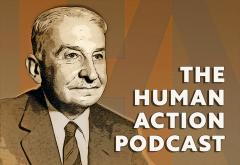It is widely held that the central bank is a key factor in the determination of interest rates. By popular thinking, the Fed influences the short-term interest rates by influencing monetary liquidity in the markets. Through the injection of liquidity, the Fed pushes short-term interest rates lower. Conversely, by withdrawing liquidity, the Fed exerts an upward pressure on the short-term interest rates. Popular thinking also suggests that long-term rates are the average of current and expected short-term interest rates. If today’s one-year rate is 4 percent and the next year’s one-year rate is expected to be 5 percent, then the two-year rate today should be 4.5 percent ((4 + 5)/2 = 4.5%). Conversely, if today’s one-year rate is 4 percent and the next year’s
Topics:
Frank Shostak considers the following as important: 6b) Mises.org, Featured, newsletter
This could be interesting, too:
Nachrichten Ticker - www.finanzen.ch writes Die Performance der Kryptowährungen in KW 9: Das hat sich bei Bitcoin, Ether & Co. getan
Nachrichten Ticker - www.finanzen.ch writes Wer verbirgt sich hinter der Ethereum-Technologie?
Martin Hartmann writes Eine Analyse nach den Lehren von Milton Friedman
Marc Chandler writes March 2025 Monthly
 It is widely held that the central bank is a key factor in the determination of interest rates. By popular thinking, the Fed influences the short-term interest rates by influencing monetary liquidity in the markets. Through the injection of liquidity, the Fed pushes short-term interest rates lower. Conversely, by withdrawing liquidity, the Fed exerts an upward pressure on the short-term interest rates.
It is widely held that the central bank is a key factor in the determination of interest rates. By popular thinking, the Fed influences the short-term interest rates by influencing monetary liquidity in the markets. Through the injection of liquidity, the Fed pushes short-term interest rates lower. Conversely, by withdrawing liquidity, the Fed exerts an upward pressure on the short-term interest rates.
Popular thinking also suggests that long-term rates are the average of current and expected short-term interest rates. If today’s one-year rate is 4 percent and the next year’s one-year rate is expected to be 5 percent, then the two-year rate today should be 4.5 percent ((4 + 5)/2 = 4.5%). Conversely, if today’s one-year rate is 4 percent and the next year’s one-year rate is expected to be 3%, then the two-year rate today should be 3.5 percent (4 + 3)/2 = 3.5%.
Hence, it would appear that the central bank is the key in the interest rate determination process. However, is this the case?
Individuals’ Time Preferences and Interest Rates
It is individuals’ time preferences rather than the central bank that hold the key in the interest rate determination process.
An individual who has just enough resources to keep himself alive is unlikely to lend or invest his paltry means. The cost of lending, or investing, to him is likely to be very high—it might even cost him his life to consider lending part of his means. Therefore, he is unlikely to lend or invest, even if offered a very high interest rate. Once his wealth starts to expand, the cost of lending, or investing, starts to diminish. Allocating some of his wealth toward lending or investment is going to undermine to a lesser extent our individual’s life and well-being at present.
From this we can infer, all other things being equal, that anything that leads to an expansion in the wealth of individuals is likely to result in the lowering of the premium of present goods versus future goods. This means that individuals are likely to accept lower interest rates.
Note that interest is the outcome of the fact that individuals assign a greater importance to goods and services in the present against identical goods and services in the future. The higher valuation is not the result of capricious behavior, but of the fact that life in the future is not possible without sustaining it first in the present. According to Carl Menger:
To the extent that the maintenance of our lives depends on the satisfaction of our needs, guaranteeing the satisfaction of earlier needs must necessarily precede attention to later ones. And even where not our lives but merely our continuing well-being (above all our health) is dependent on command of a quantity of goods, the attainment of well-being in a nearer period is, as a rule, a prerequisite of well-being in a later period…. All experience teaches that a present enjoyment or one in the near future usually appears more important to men than one of equal intensity at a more remote time in the future.1
Hence, various goods and services that are required to sustain a man’s life at present must be of a greater importance to him than the same goods and services in the future.
The lowering of time preferences, i.e., the lowering of the premium of present goods versus future goods due to wealth expansion, is likely to become manifest by a greater eagerness to invest wealth. With the expansion in wealth, individuals are likely to increase their demand for various assets—financial and nonfinancial. In the process, this raises asset prices and lowers their yields, all other things being equal.
Does Lowering the Interest Rate Permit Greater Capital Formation?
Interest rates being the outcome of the fact that life sustenance imposes a greater importance on present goods versus future goods, fluctuations in them as such do not cause more or less investment.
It is true that businessmen react to interest rates. In this sense, the interest rate can be regarded as an indicator. What permits the expansion of capital goods production is not interest rates as such but the increase in the pool of savings.
Once individuals have decided to allocate a greater amount of saved wealth toward the buildup of capital goods this decision is going to be manifested in the lowering of time preferences.
Note again, what enables the expansion of capital goods investments is the greater allocation of saved wealth toward the production of capital goods and not the lowering of the interest rate as such. The lowering of interest rates tells businesses that they should start the expansion of capital goods production in line with the instruction of consumers.
When interest rates are not tampered with, they serve as an important tool in facilitating the flow of savings toward the buildup of a wealth-generating infrastructure.
As a rule, a major factor in the discrepancy between observed interest rates and the time preference interest rate is the actions of the central bank. For instance, an aggressive loose monetary policy leads to a very low observed interest rate. The aggressive monetary pumping, however, also undermines the wealth formation process and works toward the increase in people’s time preferences, i.e., an increase in the underlying interest rate.
As the emerging gap between the time preference interest rate and the observed interest rate widens, this ultimately leads to an economic bust (note that in an unhampered market interest rates will mirror the time preference rates). Whenever the central bank lowers short-term interest rates, it falsifies this indicator, thereby breaking the harmony between the production of consumer goods and the production of capital goods. An overinvestment in capital goods and an underinvestment in consumer goods emerges. While an overinvestment in capital goods results in a boom, the liquidation of this overinvestment produces a bust. Hence, the boom-bust economic cycle. On this Rothbard wrote,
[O]nce the consumers reestablish their desired consumption/investment proportions, it is thus revealed that business had invested too much in capital goods (hence the term “monetary overinvestment theory”), and had also underinvested in consumer goods. Business had been seduced by the government tampering and artificial lowering of the rate of interest, and acted as if more savings were available to invest than were really there.2
The longer the central bank tries to maintain interest rates at very low levels, the greater the damage inflicted on the wealth formation process will be. Consequently, the longer the period of stagnation is going to be.
Interest Rates and Increases in Money Supply
An increase in the supply of money, all other things being equal, means that those individuals whose money stock has increased are now much wealthier. This will likely set in motion a greater willingness by these individuals to purchase various assets. This in turn bids the prices of assets higher and lowers their yields.
At the same time the increase in the money supply sets in motion an exchange of nothing for something, which amounts to the diversion of wealth from wealth generators to non–wealth generators. The consequent weakening in the wealth formation process sets in motion a general rise in interest rates. This implies that an increase in the growth rate of money supply, all other things being equal, sets in motion only a temporary fall in interest rates. This decline in interest rates cannot be sustainable because of the damage to the process of wealth generation.
A decline in the growth rate of money supply, all other things being equal, sets in motion a temporary increase in interest rates. However, over time, the fall in the growth rate of money supply lays the foundation for a strengthening in the wealth formation process, which sets in motion a general decline in interest rates. Also, note that the central bank has nothing to do with the underlying interest rate determination process. The policies of the central bank only distort where interest rates should be in accordance with individuals’ time preferences, thereby making it much harder for businesses to ascertain what is really going on.
Stagflation and Interest Rates
In a situation where economic activity is declining while the momentum of prices is strengthening, how will interest rates be affected? What we will have is stagflation, i.e., a strengthening in the momentum of prices and a decline in economic activity.
The key factor behind stagflation is the previous strong increases in money supply, which undermine the pool of wealth. Strong increases in money supply result in an exchange of nothing for something, which weakens the process of wealth formation. As a result, the pool of wealth is weakened, in turn weakening economic growth.
Now, increases in the money supply weaken the purchasing power of money. Hence, we have here a weakening in economic activity and a general increase in the momentum of prices. A weakening in the process of wealth generation due to the strengthening in the money supply growth rate increases individuals’ time preferences, i.e., raises the underlying interest rate.
In response to the emerging economic slump, as a rule, the central bank enters the scene to counter the slump by lifting the money supply growth rate further. This pushes asset prices higher, thereby lowering their yields. After a time lag, though, this increase in the money supply and the resultant increase in the momentum of prices is likely to prompt the Fed to tighten its monetary stance. This means that relative to the previous situation, the Fed is likely to reduce its asset buying. Consequently, an upward pressure on interest rates is likely to emerge (compounding that from the previous weakening of the pool of wealth).
This upward pressure on yields is likely to be temporary, since a tighter monetary stance is actually good news for the wealth formation process. This means that after a time lag individual time preferences are likely to be lowered, and this will work toward the lowering of interest rates.
Are We Heading for Stagflation?
The yearly growth rate of the money supply (the US AMS) stood at 79 percent at the end of February 2021 versus 6.5 percent in February 2020. This raises the likelihood of a strong increase in the momentum of prices of goods and services ahead. Because of past reckless fiscal and monetary policies, the pool of wealth could even be declining. Economic growth is likely to follow suit. This raises the likelihood of stagflation ahead. It is quite likely that the Fed is going to tighten its monetary stance by reducing the pace of asset purchases. Equally, any continuation of a loose stance by the Fed runs the risk of further depleting the pool of wealth, thereby further weakening the economy. Furthermore, because of the massive past monetary pumping, the time preference interest rate is likely to place the long-term yields on a rising trend.
Conclusions
When the central bank engages in a persistent lowering of interest rates, this policy sets in motion an increase in the underlying interest rates as dictated by individuals’ time preferences (the exact opposite of the central bank’s intention). It is not going to help economic growth if the central bank artificially lowers interest rates when individuals did not allocate an adequate amount of savings to support the expansion of capital goods investments.
- 1. Carl Menger, Principles of Economics, trans. James Dingwall and Bert F. Hoselitz (New York: New York University Press, 1981), pp. 153–54.
- 2. Murray N. Rothbard, For a New Liberty: The Libertarian Manifesto (New York: Collier Books, 1978), p. 189.
Tags: Featured,newsletter








